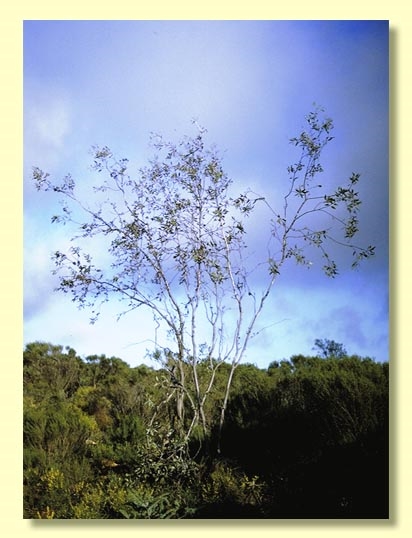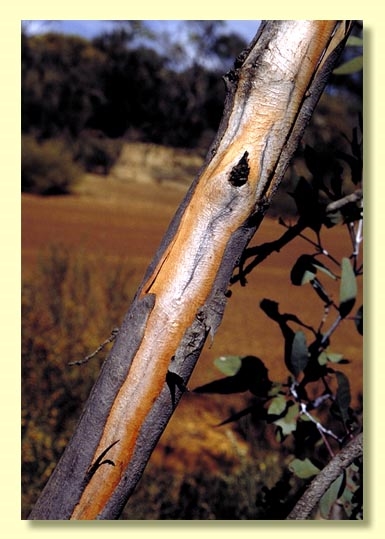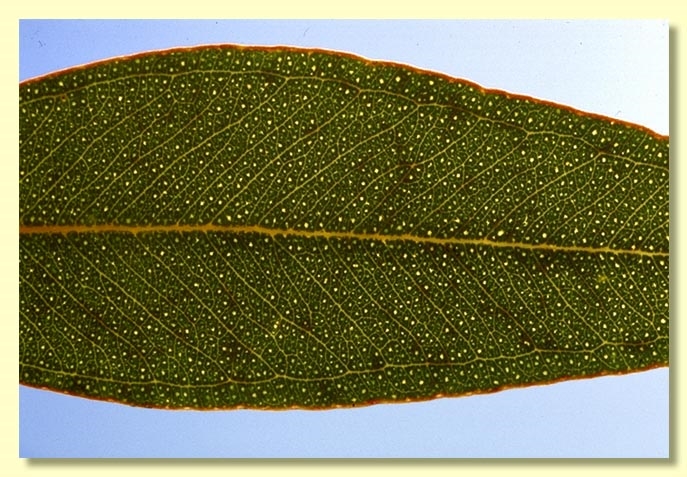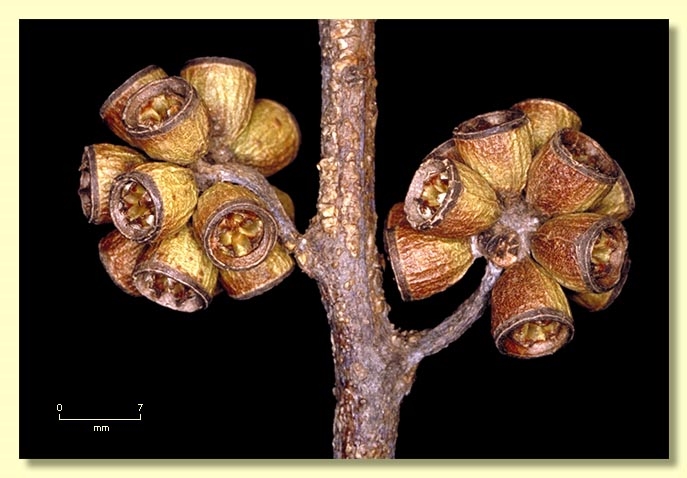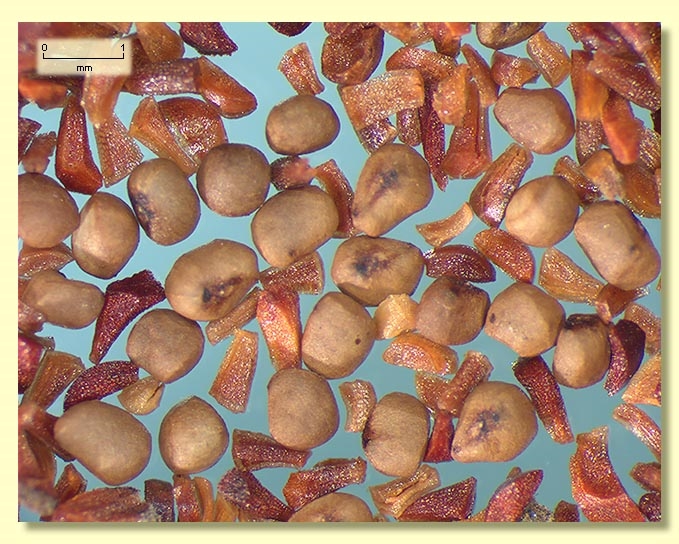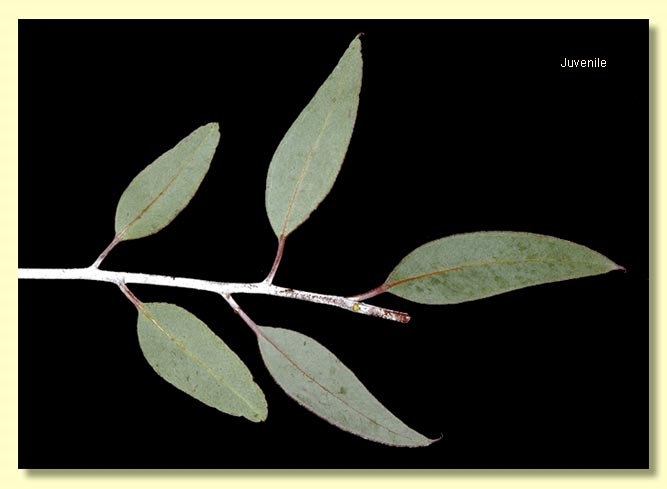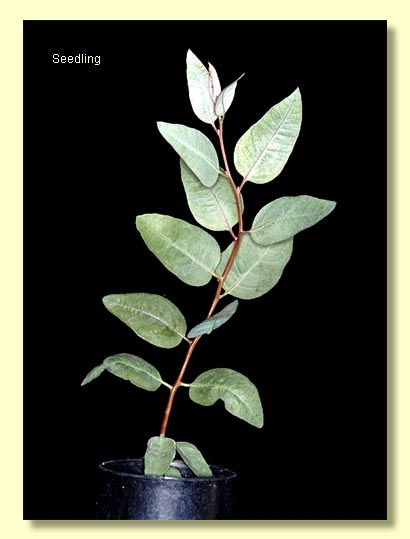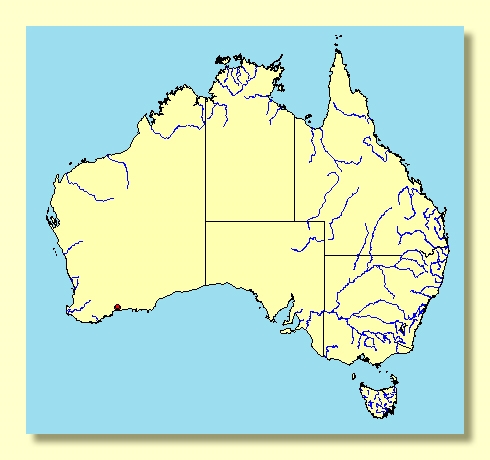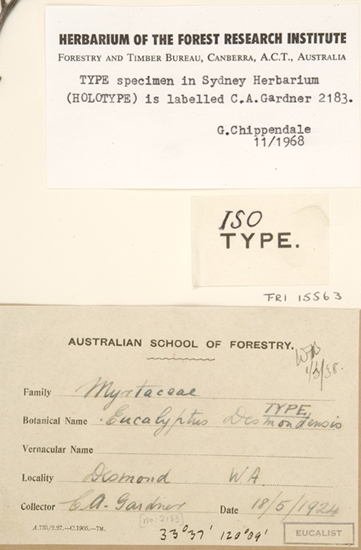Euclid - Online edition
Eucalyptus desmondensis
Eucalyptus | Symphyomyrtus | Bisectae | Glandulosae | Levispermae | Desmondenses
Spindly mallee to 6 m tall, crown sometimes drooping. Forming a lignotuber
Bark wholly smooth, grey and pale brown.
Branchlets < 2 cm diameter glaucous; lacking oil glands in the pith.
Juvenile growth (coppice or field seedlings to 50 cm): stems usually square in cross-section, usually white with wax; juvenile leaves always petiolate, opposite at lowest node only, then alternate (but may occasionally revert to opposite), ovate, 5.5–11 cm long, 2–5 cm wide, green to grey-green and dull. Reproductively mature plants may have a few opposite but mostly alternate, ovate, lanceolate and elliptic leaves in the crown; leaves always thick.
True adult leaves alternate, petioles 1.2–2 cm long; blade lanceolate, 5.5–11 cm long, 1.5–2.5 cm wide, base tapering to petiole, margin entire, apex acute and with drip-tip, concolorous, dull, green to grey-green, side-veins greater than 45° to midrib, reticulation moderate, intramarginal vein remote from margin, oil glands mostly island or obscure due to leaf thickness.
Inflorescence axillary unbranched, peduncles 0.7–2 cm long, conspicuously flattened and glaucous, buds 9 to 19 per umbel, subsessile to shortly pedicellate (pedicels 0–0.3 cm long). Mature buds ovoid to obovoid (0.7–1.2 cm long, 0.4–0.6 cm wide), non-glaucous, scar present, operculum conical and sometimes apiculate, only slightly longer than the hypanthium, stamens all inflexed, anthers oblong, sub-basifixed, dehiscing by longitudinal slits, style long and straight, stigma blunt, locules 3 or 4, the placentae each with 4 vertical rows of ovules. Flowers cream to pale yellow.
Fruit sessile or pedicellate (pedicels 0–0.2 cm long), cupular to shortly barrel-shaped, 0.5–1 cm long, 0.6–0.9 cm wide, non-glaucous, disc descending vertically, valves 3 or 4, enclosed or near rim level.
Seeds pale brown to straw-coloured, 0.7–1.5 mm long, spherical to sub-spherical, surface smooth, hilum ventral/terminal.
Cultivated seedlings (measured at node 10): cotyledons Y-shaped (bisected); stems rounded to square in cross-section; leaves always petiolate, opposite for 2 to 4 nodes then becoming alternate, ovate, 6–8.5 cm long, 3–5 cm wide, green to grey-green or with faint waxy bloom.
Flowering has been recorded in January, March, April, May, June, August, October and November.
A small mallee endemic to Western Australia, restricted to the Ravensthorpe Range area, particularly on stony granitic soils. The bark is smooth and the adult leaves dull, green to grey-green.
Eucalyptus desmondensis is a somewhat anomalous species in Eucalyptus subgenus Symphyomyrtus section Bisectae subsection Glandulosae because whilst the cotyledons are bisected and the buds have an operculum scar, as do other species in this group, the branchlets lack the characteristic pith oil glands. Within this subsection E. desmondensis is clearly linked to the ca 35 species and subspecies that form series Levispermae because of the smooth pale spherical seed which are found only in that group. E. desmondensis also has peduncles that are strongly flattened, but unlike most species in this series it has non-fusiform buds and all stamens inflexed, and lacks pith glands in the branchlets.
The slender spindly erect mallee habit with few leaves in the crown, the white waxy over claret-coloured branchlets, flattened, waxy peduncles and non-waxy sessile buds make this species distinctive. Within its restricted natural range it should not be confused with any other eucalypt.

